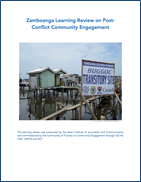
Small-scale farmers bear the brunt of El Niño in southern Mindanao
Breadbasket of Mindanao hit by prolonged dry spell
While the rain brought by Typhoon Melor (known locally as Nona), Tropical Depression Onyok and the northeast monsoon brought much-needed respite from the drying effects of El Niño, large areas of the Philippines are expected to suffer drought in the coming months. Small-scale farmers in southern Mindanao are already suffering a big drop in crop production, and fear that El Niño might push them further into debt.
Region XII of the Philippines, composed of South Cotabato, North Cotabato, Sultan Kudarat and Sarangani provinces, is considered to be the breadbasket of Mindanao. Mindanao accounts for over 40 per cent of the country’s food requirements and contributes more than 30 per cent to the national food trade according to FAO. Farmers here produce staple crops including rice and corn and cultivate large plantations of cash crops such as bananas and pineapples.
The prevailing El Niño has led to dry conditions in 2015. Sarangani province in particular recorded below-normal (40-80 per cent of average) rainfall for seven months and way-below-normal (less than 40 per cent of average) rainfall for three months, according to the Philippine Atmospheric Geophysical and Astronomical Services Administration (PAGASA)
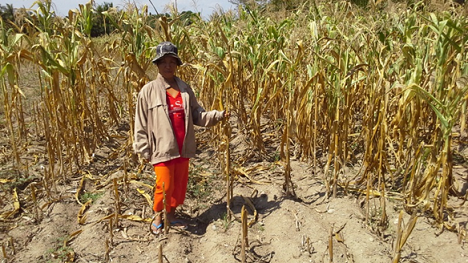
Landless farmers without coping mechanisms suffer production loss
For Jennie Korbo, a small-scale farmer in Alabel municipality of Sarangani, waiting for the rain was not an option. She grows corn on her rented 1.8-hectare land, which yields 3.7 tons or 148 sacks of corn during a normal farming season. Due to frequent water shortage this season, her corn has been withered and she is expecting to harvest less than 1 ton or about 40 sacks.
Though she had heard about El Niño and its effects on the radio, she took the risk of planting in August 2015 because she could not afford to delay harvest. In addition to PhP7,000 (US$147) annual rent for the farmland, Jennie had borrowed P30,000 ($628) to buy seeds, fertilizer and chemical spray for the corn. With most of her corn damaged, she lost over P10,000 ($209) net profit this season and can pay back only P8,000 ($167) out of her loans. A working mother of five, Jennie is worried her family might remain in debt for several farming seasons to come.
Many landless farmers in Mindanao share similar stories. While they cultivate one of the richest farmlands in the country, they are often chronically food insecure. A single bad harvest can strain their already-poor access to food as well as their income to purchase alternatives. Coupled with low literacy levels and a dependence on rural livelihoods, they find it extremely difficult to cope with the impact of El Niño.
The Government steps up mitigation measures
The Department of Agriculture (DA) through its regional office has taken various measures to mitigate the impact of El Niño to support farmers like Jennie. These include distribution to affected farmers of water pumps and replacement seeds of drought-tolerant and early-maturing crop varieties, and the construction and rehabilitation of small impounding projects, diversion dams, and irrigation canals. Pest surveillance and cloud seeding have also taken place. In addition the DA engaged in information and education campaigns to raise awareness on how to cope with El Niño through conducting training on soil and water conservation and climate change adaptation by a shift in cropping calendars.
The provincial and municipal authorities of Sarangani and Alabel are also assisting affected farmers through the loan of tractors to rehabilitate farmlands, purchasing additional rice and corn seeds for distribution, and providing strategic guidance to increase production in areas not as badly affected by El Niño.
85 per cent of the country projected to experience drought by April
The PAGASA predicts that El Niño will remain strong until February and most provinces in central and western Mindanao will continue to experience below-average rainfall from January to April. By the end of April, 85 per cent of the country including the whole of Region XII will face drought. The DA is carrying out an impact assessment on food security with production data to be compiled by March.
Persisting dry conditions and the resulting water shortage may also have health implications. The local health station in Jennie’s neighbourhood reported increased incidence of diarrhoea, cold-like symptoms and hypertension over the recent months. Skin disease is also on the rise. Health workers fear that El Niño may worsen the situation and increase malnutrition among children.
Jennie’s hand pump is drawing less and less water to her farm now. She plans to install additional pipes to reach the receding water table to save her surviving corn.

Drought: defined as three consecutive months of way below normal (less than 40 per cent of average) rainfall or five consecutive months of below normal (40-80 per cent of average) rainfall.
Dry Spell: defined as two consecutive months of way below normal (less than 40 per cent of average) rainfall or three consecutive months of below normal (40-80 per cent of average) rainfall.
Credit: OCHA
Extensive damage to rice and corn production in Region XII may worsen the prevailing chronic food insecurity among the vulnerable people in Mindanao.
Triple weather disturbances hit the Philippines
Over 700,000 people pre-emptively evacuate ahead of typhoon landfall
Amid the response to Typhoon Koppu (known locally as Lando), which battered central and northern Luzon in October, three more weather disturbances affected the Philippines in December.
From 14 to 16 December, Typhoon Melor carved through central Philippines bringing destructive winds of 150 km/h and gusts of up to 185 km/h, and heavy rainfall. 743,000 people along the typhoon’s projected path pre-emptively evacuated to safer ground. Typhoon Melor made five landfalls in the provinces of Northern Samar, Sorsogon, Masbate, Romblon and Oriental Mindoro, leaving a trail of destruction which resulted in 42 deaths, over 270,000 damaged houses and P6.45 billion ($135 million) in damage to agriculture and infrastructure.
Authorities were still assessing the impact of Typhoon Melor when Tropical Depression Onyok made landfall over Davao Oriental province in Mindanao on 18 December. It dumped heavy rains over Mindanao, providing relief to parched lands suffering the effects of El Niño. The tropical depression also enhanced the northeast monsoon, bringing heavy rain over the eastern parts of Luzon, Metro Manila and the Bicol Region and further hampered the recovery in areas affected by Typhoons Koppu and Melor.
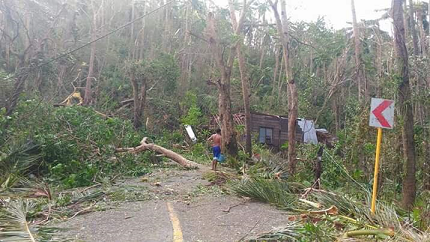
State of national calamity declared to facilitate localised response
The President of the Philippines on 18 December declared a state of national calamity to allow local authorities to access funds from the national budget to hasten rescue, relief, recovery, and rehabilitation efforts.
The Government’s response to the successive weather events was indicative of its efforts to devolve operational leadership for preparedness and response from the national to regional and local authorities. This was supported by the Government’s early warning system that provided timely and improved hazard information to facilitate local action.
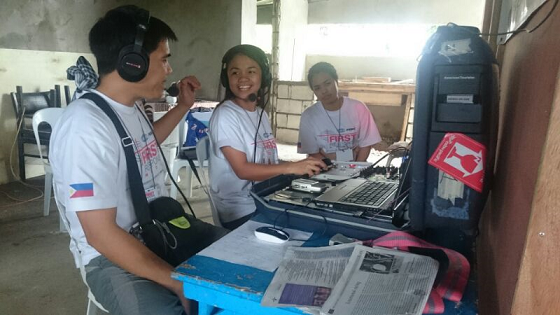
Humanitarian Country Team provides targeted assistance
Members of the Humanitarian Country Team (HCT) and its partners provided targeted emergency shelter, food and non-food items, logistics, water, sanitation and hygiene, health, early recovery, livelihood, and community engagement support as requested by government departments and affected local authorities, and as assessments revealed the need. This was done in a manner similar to the response to Typhoon Koppu – with assistance mobilised primarily with resources available in the country – following the Government’s preference.
To build on the lessons of the response to recent weather disturbances, the HCT proposed an after action review with the Government in early 2016. In particular, many humanitarian agencies in the Philippines relied on relief items stocked from previous emergency operations to respond to the Government’s request for assistance with in-country resources. These supplies however are finite and need to be replenished ahead of another disaster.
In parallel to the discussion on international resources mobilisation, the HCT will continue to support the Government to develop a framework for joint rapid needs assessments. This will be aided by appropriate technologies and procedures for effective information gathering, sharing and analysis.
Way forward for Zamboanga IDPs
Visit of the Humanitarian Coordinator and the Way Forward workshop
As of 4 January, some 16,900 internally displaced people (IDPs) remain in 12 transition sites across Zamboanga City. They have been waiting for a new home where they can rebuild their lives since the September 2013 fighting between government forces and factions of the Moro National Liberation Front. With little progress in the construction of permanent housing, most of these IDPs are expected to remain in the transition sites well past March. In addition, an estimated 7,700 “home-based” IDPs are continually hosted by relatives and friends or renting temporary homes.
Mr. Ola Almgren, the UN Resident and Humanitarian Coordinator in the Philippines, visited Zamboanga City from 10 to 11 December. In transition sites and permanent housing site, Mr. Almgren spoke with camp managers and displaced families who raised concerns over the lack of water and livelihoods. He also met with the city mayor and the Zamboanga Mindanao Humanitarian Team (ZMHT) to discuss remaining humanitarian and recovery needs.
On 17 December, ZMHT members invited sectoral representatives of the city authorities to discuss key residual concerns for the IDPs and ways forward in recovery. CFSI, CRS, FAO, ILO, IOM and UNHCR confirmed to maintain its field presence in Zamboanga into 2016. These agencies will continue to support the city authorities with temporary and permanent shelter, sustainable livelihoods, camp management and protection assistance.
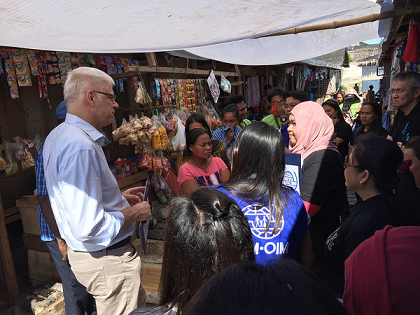
Zamboanga City authorities declare a state of calamity due to El Niño
Zamboanga City re-introduced periodic water rationing on 8 January as the water level of the local dam reached a critical level due to the persistent dry spell. On 12 January, the city authorities declared a state of calamity to allow implementation of contingency plans using the Government’s calamity fund. Tension between the displaced families and their host communities is escalating due to insufficient water supply. The impending drought may exacerbate the relationship between the communities.
In brief
Zamboanga community engagement learning review report released
The report of the Zamboanga Learning Review on Post-Conflict Community Engagement was released on 14 January. The report captures good practices and lessons of the Zamboanga Communications Working Group’s community engagement efforts. The group was established in October 2013 under the leadership of the City’s Public Information Office and comprises international and local aid agencies. It facilitates humanitarian communications and accountability of aid to the displaced families. The report underscores the importance of mainstreaming two-way communication, community participation and common service partnerships in all emergency response programming including in post-conflict settings.
